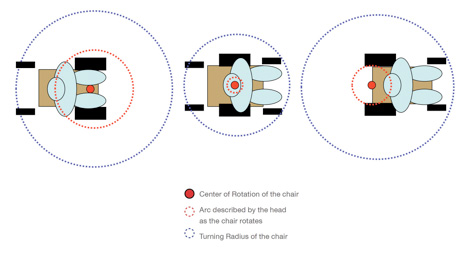Share:
Hello all!
If you have been following my blog, you will know that I previously have written a series of articles on de-mystifying power wheelchairs. I wrote about batteries and motors, the controller, and selecting electronics. These articles are available on Clinical Corner and can be found by using the Search feature in the upper right corner. This month, I would like to continue to focus on power mobility, by comparing mid-wheel, rear-wheel and front-wheel drive power wheelchairs, as it is important to understand how drive base affects the performance of a power chair.
The graphic below provides a visual representation of the three types of power mobility bases. From left to right, the graphic illustrates a front-wheel drive, a mid-wheel drive, and a rear-wheel drive power base. The thicker rectangles represent the drive wheels of the chair while the thinner rectangles represent the casters.

In a front-wheel drive chair, the drive wheels are in front of the person using the power chair. In a mid-wheel drive chair, the drive wheels are directly under the person driving the chair. Lastly, in a rear-wheel drive chair, the drive wheels are behind the person operating the chair.
One of the other things you will notice in looking at the above graphic is the relative size of the turning circumference of each type of chair. As you can see by the dotted blue line, the turning circle of a mid-wheel drive chair is smaller than that of a rear-wheel or front-wheel drive chair. The smaller turning circumference allows for greater maneuverability of a mid-wheel drive chair in tight places as a mid-wheel drive chair turns on its own axis. Mid-wheel drive wheelchairs often are favoured by those using them in predominately indoors because of their maneuverability, particularly in limited spaces.
In addition, a mid-wheel drive chair will be more intuitive to drive than either a front-wheel or rear-wheel drive chair. The reason for this is because the driver's head is directly over the drive wheels so that as the chair turns the centre of rotation of the chair coincides with the centre of the arc of the head that is made when the chair turns.
With a front-wheel or rear-wheel drive wheelchair, some driver education is required to compensate for the relative position of the driver to the drive wheels. In a front-wheel drive chair, the driver must become accustomed to the length of the wheelchair behind the driver. I liken this to driving a semi-trailer truck when turning a corner at an intersection. When I watch such a truck turn a corner in an intersection, I notice that the driver must drive a little beyond the intended turn before turning to take into account the length of the trailer and to ensure adequate clearance of the trailer behind the driver so that the trailer does not "cut" the corner.
For a rear-wheel drive power wheelchair, the driver must become accustomed to the length of the wheelchair in front of him/her and take this into account when driving. I liken driving a rear-wheel drive chair with pushing a grocery cart. To turn a grocery cart down an aisle, a person must first clear some of the aisle before initiating the turn or the side of the grocery cart will catch on the end display. Driver education may help to overcome these issues inherent with rear-wheel and front-wheel drives. For people with perceptual and/or cognitive impairment, however, the choice of a mid-wheel drive power chair may be easier to learn to operate because of the intuitiveness of driving it.
Another consideration when deciding between power bases is the performance in climbing obstacles or inclines. A front-wheel drive power chair may climb obstacles well due to its large front drive wheel. With any power wheelchair, however, it is usually the footplates that are the first object to encounter the obstacle and may interfere with climbing the obstacle.
Finally, another factor to consider when choosing between a rear-wheel, front-wheel or mid-wheel drive power wheelchair is overall stability of the wheelchair. Traditionally, both a rear-wheel drive and a front-wheel drive power wheelchair have offered greater stability than a mid-wheel drive chair. In these two types of chairs, the centre of mass of the individual is positioned between the drive wheels and the casters, which offers stability for the user. A rear-wheel drive power chair will have the best directional stability at high speeds because most of the weight of the chair is in the area of the drive-wheels. For a front-wheel drive chair, directional stability can become a challenge at high speeds as the front loading of the drive wheels may cause "fish-tailing" behind the centre of gravity. In a mid-wheel drive chair the user is positioned at the drive wheels and because this type of chair has a smaller footprint than the other two types of chairs, pitching can occur and this may be accentuated when outdoors. It is important to note that the type of suspension used on a mid-wheel drive chair can minimize the pitching associated with such a chair, so it is important not to overly generalize based on drive-type.
When deciding between mid-wheel, rear-wheel, or front-wheel drive power wheelchairs, it is important to consider the environment in which the person will be using the wheelchair. Will the environment be primarily indoors? Outdoors on uneven terrain? What are the accessibility and maneuverability requirements? What is the maximum speed required? Is the client accustomed to driving a particular drive wheel configuration? What is the client's preference? There are many different factors to consider in deciding upon the optimal drive base for an individual user and what works well for one person may not work well for the next person. Trial of equipment is key to knowing what will work well for a particular person.